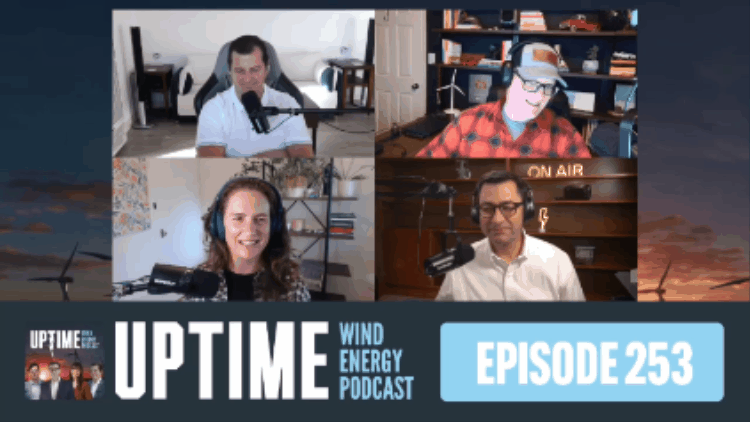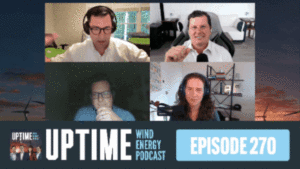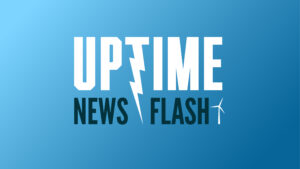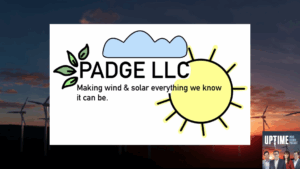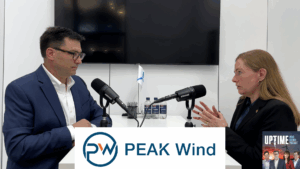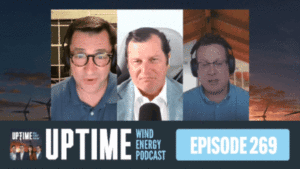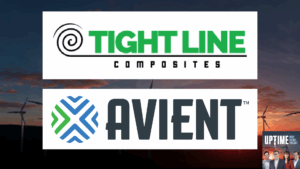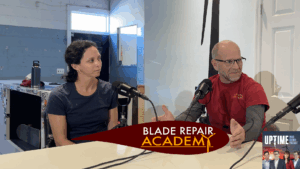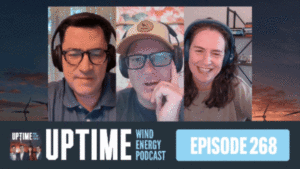Podcast: Play in new window | Download
On Uptime this week, we discuss Nordex’s installation of a 179 meter hub-height wind turbine in Germany, the expected drop in oil prices in the US, and the emerging “hushed hybrid” trend.
Fill out our Uptime listener survey and enter to win an Uptime mug! Register for Wind Energy O&M Australia! https://www.windaustralia.com
Sign up now for Uptime Tech News, our weekly email update on all things wind technology. This episode is sponsored by Weather Guard Lightning Tech. Learn more about Weather Guard’s StrikeTape Wind Turbine LPS retrofit. Follow the show on Facebook, YouTube, Twitter, Linkedin and visit Weather Guard on the web. And subscribe to Rosemary Barnes’ YouTube channel here. Have a question we can answer on the show? Email us!
Nordex breaks records with their tallest onshore wind turbine. Wall Street predicts conservative oil and gas spending for 2025 and Australia prepares for the wind energy O&M conference. This is the Uptime Wind Energy Podcast.
You’re listening to the Uptime Wind Energy Podcast, brought to you by BuildTurbines. com. Learn, train, and be a part of the clean energy revolution. Visit BuildTurbines. com today. Now here’s your hosts, Allen Hall, Joel Saxum, Phil Totaro, and Rosemary Barnes. Well, you won’t want to miss the Wind Energy O& M Australia event because it’s coming up soon, February 11th and 12th in Melbourne.
And at this point, Phil, there’s like 65, 67 different companies represented at this event. Yes, uh, we’ve got about 125 people registered at this point and all our sponsors are on board. So a big thank you to Tilt Renewables, GE Vernova, Winergy. Uh, warley rig com. Skys specs and aons. That’s gonna be quite a crowd.
And, and the, the panels I saw, if you go online to wind australia.com, you can see all the different panels we’re talking, leading edge erosion, some lightning strikes, CMS. Pretty much anything to do with wind turbines we’re going to be discussing and because we’ll have all the experts there at one place It’s the right time to get your questions answered and even Rosemary is going to be talking on a panel and hosting a panel A couple in fact, I’ve got leading edge erosion and then end of life Considerations what to do at the end of life of wind turbines.
So looking forward to both of those And Joel, you’re hosting a panel on insurance, correct? Yeah, I was actually speaking with some of the people that are going to be involved in it today, and they’re super excited about being able to actually engage with the public that they don’t get to, or they engage with the wind industry that they don’t normally get to.
So they want to share their messages in operational strategies and how to deal with your insurers. Yeah, it’s a really different crowd to what, um, I typically see at Australian conferences or most, even the international ones where it’s much more about, I don’t know, finance and developing and, um, maybe politics a little bit, community engagement, all important things.
But, um, yeah, I’m always, always missing the really technical stuff. And obviously that’s why we organized this conference, but it’s, it’s, It’s been good to see the kinds of attendees that have been registering, and I think that we are gonna hit that brief of getting a, you know, a really good technical discussion going about what are the problems that we’re facing in Australia and what are the solutions and, you know, learning, um, all of us learning together.
So, um, yeah, I’m really excited for, it’s only a few seats left. If you want to attend Wind Energy o and m Australia, you need to go to wind australia.com and click the button and register. Literally, there’s like a handful of seats left. Better do it now, and we’ll see you in Melbourne. Unlock your wind farm’s best performance at Wind Energy O& M Australia, February 11th to 12th in sunny Melbourne.
Join industry leaders as they share practical solutions for maintenance, OEM relations, and asset management. Discover strategies to cut costs, keep your assets running smoothly, and drive long term success in today’s competitive market. Register today. and explore sponsorships at www. windaustralia. com.
There’s a new workplace trend called hushed hybrid and it’s gaining attention where managers quietly allow their teams to work remotely despite company policies requiring office attendance and I’ve seen this up close. I didn’t realize this was happening, but there is like an underground black market for working at home.
Now, research shows that about 70 percent of UK managers are now practicing this approach, uh, which is highlighting, uh, the return to office mandates that a lot of people don’t want to come back and the managers really don’t need them to come back, and so they’re negotiating on a person by person basis.
And they’re finding that People quit less if they can work out of the house, maybe even just a couple of days a week. Uh, and it’s leading to more job satisfaction. Now, before we started recording today, Rosie was talking, uh, about a situation she’s involved with, which is sort of the opposite, they want you to not come into the office for office Real estate reasons, I guess.
Yeah. Yeah. My friend, my friend, Brian, he, um, had an office, but there were not that many people in there. They were allowed to work from home when they wanted to anyway. But anyway, the company just saw that it was underutilized. Didn’t like how much they were spending and kicked them out of their real office.
Got them some coworking space. And yeah, usually most people are just choosing to stay home because. Coworking spaces are a bit of a pain. You know, you get inconsiderate. Coworkers, except for they’re not your coworkers, so that you can’t, you can’t actually complain to them. It’s a different person every day.
And. Yeah, so that, that’s one example, but I was also reflecting recently how, um, I work from home mostly. I, I do have an office I can go to. Um, and I do sometimes, I actually miss the office. I, I feel like I’m kind of like paused in my career at the moment while I’m working so much from home, but at the same time, I kind of need it while I’ve got a young kid and just, yeah, always so much, so much stuff to do in so little time.
And I just thinking through, Yesterday, like I, um, I had to do some research and I was watching YouTube while I was chopping carrots. Um, I was removing my nail polish while I was participating in a meeting. Um, I don’t know, any number of things like that. You can iron or fold laundry or, you know, lots of things.
If you’ve got work where it’s mostly talking. really convenient to be able to multitask like that. But I mean, I personally miss having an office to go into or a workshop to go into even better with, you know, physical things are happening and you’re seeing technologies. I don’t feel like I’m going, like I’m, you know, trading off the experiences that I’ve had in the first 20 years of my career, not getting a whole lot more right now.
And I would really. I’d like to change that at some point in the future. Do you think, Joel, because of the return to office mandates that are happening at the moment, do you think that they don’t, the companies don’t want to pay for the real estate that they own, that they’re looking to cut costs because interest rates are not going to come down, as I learned today?
Uh, that they’re gonna, they’re gonna start selling the properties, which I do see a number of companies, large companies. getting rid of major properties and telling everybody like work from the house. Yeah. If you, if I’ve talked with a commercial real estate friend in Houston, uh, a couple months back and they were talking about, it’s a really weird market because there’s good stuff available.
Um, and the prices, you know, they want that premium for prices, but nobody’s willing to pay it. People are cutting back. And there was a couple of things he talked about where during COVID they actually had. Leaseholders approach them and say, Hey, we’re breaking our lease. Claiming COVID is force majeure in the contract to be able to try to get, to be able to try to get out of it.
And I don’t know where they ended up. I’m sure that lawyers talk to lawyers and that kind of stuff, but yeah, it’s, it’s upended the commercial real estate market big time. And right now you see, again, people trying to, you don’t see a whole lot of like, you know, baseless commercial real estate going up.
Maybe companies that are big that are building their own facility. Yeah. But you’re not seeing these large rental spaces. And when you do see them, you’re seeing for, for lease, for lease, for lease, or, you know, for sale on the bottom of it. So is the plan now for. People on wind, if they’re in the office right now, is to check the commercial listing to see if that building is for sale and think, okay, I got to work from home.
Maybe now’s the time to put my application in to go back, go back to the house office. I think that the, you know, this is another story of talking with another friend that works in the software industry. They tracked through COVID. They actually had, like, partial the way through COVID, they had increases in productivity in their software engineers when they were working from home.
Like in, you know, in the double digits, 10, 12 percent were actually getting more done than they were when they were coming into the office because they’re not hanging out BSing in the hallways. And I think the other side of it, this hush, the hush hybrid working, if you’re a manager that needs, say, these software engineers or these people or whoever it may be, And you’re being, you have this top down going, you need to, that, you know, they’ve got to be back in the office.
You don’t want to have a mutiny on your hands. You still need to get some stuff done. You don’t want to lose team members. So that’s why I think they’re insulating or buffering some of these people that they’re just kind of like, yeah, it’s great. You know, just keep, keep doing what you’re doing. Um, and not, you know, listening to them or abiding by the mandates.
I’d do it though. I mean, if you have a good, a good, um, person working for you, then, you know, and, and work from home is important to them, someone else will snap them up if you, um, if you won’t allow it. So, I think that, um, Yeah, I don’t know. I would be, I would be flexible on it if I had people that I wanted to keep whilst also trying to get people to, you know, like think about what, what aspects of return to office are needed.
I think what people really complain about is when there’s no point, you know, like if you go into the office, you’re forced to go into the office and you sit all day on your computer on Zoom calls, then that is just incredibly frustrating. It feels really disrespectful of the employee’s time. But, you know, if you’re in there for specific purposes, um, and that includes, you know, teamwork purposes and definitely projects go much faster when you’ve met people in person and, you know, spend a little time with them.
I think, you know, like you’ve really got to make people understand why they need to go back in the office and, um, what’s in it for them, what’s in it for the quality of their work. And then that will work a lot better than just making an across the board mandate. And then, you know, yeah, like I said, going and sitting on Zoom calls all day, it’s just like, that’s going to piss you off and make you want to quit your job for sure.
As busy wind energy professionals, staying informed is crucial. And let’s face it, difficult. That’s why the Uptime Podcast recommends PES Wind magazine. PES Wind offers a diverse range of in depth articles and expert insights that dive into the most pressing issues facing our energy future. Whether you’re an industry veteran or new to wind, PES Wind has the high quality content you need.
Don’t miss out. Visit peswind. com today. Nordex has achieved a notable milestone in wind turbine technology with its latest installation in Germany. The company’s N175 6X turbine now stands at an impressive hub height of 179 meters. Now I had to do the math on that. That’s about 580 feet, which is, makes it the tallest turbine ever, uh, constructed by the Nordex group.
Now, a couple of things about this, Nordex likes to use concrete steel towers, and this uses that technology. And, uh, obviously if you’re going that high, you have to have an insert to improve concrete design. But they are talking about. Having these hybrid towers grow to 200 meters, which would be 650 odd feet.
This is remarkable. And I, and Rosie’s talked about this a number of times, like the higher you go, the better the winds are. And on a six megawatt machine, you probably want to push that up as high as you can. And when you’re crossing 500 feet on the tower with a six megawatt generator on top of it. This is a huge machine.
Is this had a limited scope as to where it can be placed? Is it just gonna be Germany or maybe in northern Europe? Because I just don’t see this being placed in Texas or Kansas or Illinois, Phil. I’m surprised to hear you say that because I thought it was nearly the opposite that Europe is more using small machines in places like the US and Australia.
And I definitely, I know Australia moving more towards big ones. I mean, I hear a lot of developers for some of these really big new Australian projects that are hopefully imminent. They’re looking not just six megawatts, but you know, like 10 megawatts. Megawatts or whatever they can get their hands on the biggest.
Um, so yeah, I would have thought that what you need to go that big is to be not in a really built up area and there’s, yeah, not much of Europe that’s not very built up, but I could be totally wrong. I think in Germany, the reason they’re going to some of these bigger cities. big ones is simply because they’re land constricted, right?
They want to get as much renewable energy production out of the small amounts of land. Is it a small wind farm that only has like maybe two or three turbines? So they’re not too worried about, yeah, like if you’ve got a bigger wind farm, then you’ve got to worry about the spacing distance, which obviously increases with the height of it.
Um, yeah, that makes sense. If it’s one or two turbines there, then. You don’t have to worry about, um, how, how far apart you’re going to have to put the next turbine because there isn’t going to be one. And we’re, because we’re not land constrained in markets like the United States or, you know, Brazil, Argentina, I mean, you would think like if you wanted to put a tall tower somewhere it’d be a, maybe a place like Argentina, but you don’t even have to, uh, in a market like that because you’ve got such strong, consistent, uh, Um, average wind speeds, um, that it’s just not necessary.
So in, again, in a market like the U. S. where we’re not land constrained, we can spread projects out, um, and we don’t have to necessarily go as tall because we still have, you know, transportation and logistics constraints that, that also kind of preclude us from, from doing that. Okay. Um, we’re still getting a lot of, you know, components imported and we have to load them on trucks and trains, uh, to be able to get them to a project site.
Now, while a hybrid tower with a concrete base and a steel tube upper, uh, is, uh, Conducive to that, that type of approach where you could technically have the staves of concrete trucked out to a site and then just kind of pick them, you know, with a crane and put them together. Um, it’s still something that we just haven’t really explored.
Alan, do you think when they developed this thing, they called our friend Gio a 3S lift? They better have a lift. Can you imagine climbing that? I thought about that today, like, man, 500 feet. That’s a lot of climbing with the gear on your back. Yeah, that’s, that will not be fun. But I guess it adds to the question of what do you do about the crane, right?
The crane has got to be massive to do this. Do you even have the crane in the United States to do it? Or Australia, even. Does it make sense to do this? And we’ve seen all the technology around those, uh, devices that you can build the tower with it without using a crane and to make it simpler, but still 500 feet.
It’s still pretty tall. Yeah, well, one of the companies that I know that’s interested in really big turbines for onshore in Australia is Fortescue, who, you know, planning wind energy to support their, um, They’re net zero ambitions or plans, I should say, rather than ambitions. And they have, um, just increased their investment in narrow wind who, um, have got, uh, yeah, one of, one of the several solutions out there for really big turbines or several, actually, they’ve got the tower solution and they’ve got the blade installation solution.
I can’t remember. Um, there’s a couple of things, so I think that they are looking at that. Let me ask you a question, Rosemary, because you’re, of course, more engineering savvy than I am. But is there a future where we have two turbines, or like, multiple sizes of turbines, co located in the same wind farm to take advantage of wind resource?
Like, say they get up to 200 meter towers and they put this big thing way up there. Is there, can we put a two megawatt turbine mixed in the wind farm to take advantage of those? The wind speeds below. I have seen research where they, yeah, tried to catch two slices of the wind, one really high and one lower down.
And in the end it, like the benefit that you got was not worth the hassle of it. Cause basically it’s the tall one that’s, that’s doing everything. And then the small ones, it’s like, Oh, it’s not worth the effort to add this, to add this in. So, um, yeah, so it tends not to be used even though, yeah, the benefit doesn’t exist, like you’re saying, but.
I haven’t seen it actually used beyond an academic paper or two. And it’s got to be adversely impacting productivity for some of the smaller turbines, you know, because the, the wind, the, the taller turbines are going to suck up more of the, the, the You know, the available wind, basically, and, and, uh, draw that into the, the rotor plane, um, and it actually does, you know, ding the performance a little bit of the smaller ones, but, um, you know, it depends, it depends on how you’re actually doing the layout and, um, uh, you know, as Rosie said, I think the, the cost benefit doesn’t trade well enough for, for the OEMs to be recommending that.
I think you also can’t underestimate how much just like the, um, the extra time that it adds on to running a wind farm really matters because nobody has enough time to do all the things that they should be. You definitely do want to think about not making things harder than necessary for the team that has to operate a wind farm.
But lightning damage is not. Actually, it’s very predictable and very preventable. StrikeTape is a lightning protection system upgrade for wind turbines made by WeatherGuard. It dramatically improves the effectiveness of the factory LPS, so you can stop worrying about lightning damage. Visit weatherguardwind.
com to learn more, read a case study, and schedule a call today. So despite calls for increasing drilling from some U. S. political quarters, Wall Street is anticipating conservative spending patterns from U. S. oil and gas companies in 2025. Now, analysts expect companies to maintain their focus on shareholder returns, but oil prices are not going to rise very much.
In fact, they’re expected to drop down about 5 per barrel. At a point that doesn’t make it really profitable to, to drill baby drill. Now this has sort of a follow on effect where, uh, a lot of, uh, mergers and acquisitions have slowed down, especially in Q4 of last year. So, the oil companies themselves are not looking to drill baby drill, they’re looking to hold on to cash.
And I have seen layoffs happen, and as Joel pointed out recently, last episode, the number of drill rigs is down, which is an indication of how much they really want to pump from the ground. That opens up another avenue for renewables to step into, and this week with DeepSeq, which is the Chinese AI bot that uses a lot less, supposedly a lot less, uh, computational power and can use, um, older styles of chips, and they developed this, uh, AI model with about six million dollars, supposedly, uh, All of the money that was headed on Wall Street to natural gas, uh, electricity sites has quieted quite a bit, and the GE Vernova stock dropped, what, like 90 points in a day because of that?
Uh, so, if we’re not going to build data centers to power all the AI, and oil and gas is expecting the price of oil to drop, Where are we going to get new electricity from, guys? If we’re not permitted to build renewables, I don’t know. Well, you’re still permitted and no one’s stopping the permitting. How many wind turbines are on federal land, Phil?
I will tell you precisely because we just researched this for a client. So, this order to restrict renewable energy development, particularly wind, on federal lands, actually impacts about, uh, seven gigawatts worth of what’s in the consent pipeline right now. Now, that may not sound like a lot, but when you consider that in the next, you know, four years, let’s say, uh, we’re only going to be adding something like 40 gigawatts anyway, that is a decent percentage.
All right. It’s noteworthy, Joel, but Where are they going to get the electricity? Where’s Oklahoma and Texas and Kansas going to get their power from because they’re not getting it from federal lands at the minute. That’s true. But if you look at what’s on federal lands right now, it’s just not very much.
And part of that is just because it’s a nightmare. It is an absolute nightmare to build on federal lands, whether it’s an oil and gas project, a wind project, whatever. But there is a lot of oil and gas projects on federal land. But it’s because oil and gas projects operate in big margins, right? But an interesting article that came out, uh, just yesterday was Chevron pairing up with GE Vernova to power data centers.
So they’ve put an, they put an order in as a kind of like a joint venture with Chevron. And GE for seven gas turbines. At the same time, you had this crazy deep seek thing come from China, spook the entire market. Nextera stopped, dropped, GE, Vernova stock dropped, NVIDIA, all the AI people, their stock dropped.
Um, I think that there’s two, there’s two, there’s two fields of that. There’s two, two families. There’s one saying, well, if. If it’s going to become cheaper to do AI computing, well then we can just have more and more and more AI, so it’s going to keep growing anyways. That’s one side of it, and the other side of it, well, is like, well, maybe it’ll tabletop or stagnate because we don’t need that much power.
But, when I think when you see big players still, I mean, G. E. Vranova’s stock regained 6 percent or something today. So I think that it’s a spook market, people buying dip, things going back. Like, I don’t think it’s going to have long term effects on the market with this deep seek thing, but to the oil, main oil industry players, when you see major players getting in, it’s, it’s a, it’s a big sign.
Rossi, I want to move over to coal for a minute. There’s a lot of countries in Eastern Europe that are talking about starting or building coal fire generation plants all of a sudden. Is that something you’re hearing from Australia? Australia being one of the places where coal is plentiful. Is, is that happening?
Are you hearing that news? Uh, it’s not, it’s not in Australia’s plans. No, I don’t think that it ever will be unless we’ve got, at the moment, we’ve got an election coming up. And I think one of the big issues in the election is going to be, um, whether we continue with our energy transition based on wind and solar power, which is what the current government wants to do.
Or if we decide to start from scratch a new nuclear power industry, um, instead, which will mean halting renewable plans quite in the quite near future, because we would have too much energy otherwise, if we both continued with renewables and built new nuclear. And then the issue with that is that, uh, starting from a totally standing start with is not even legal in Australia at the moment.
So we would need to. First do all of the legal stuff that’s required, develop a regulatory framework, then, you know, actually start the process of designing and building and staffing a series of nuclear power plants. That’s going to take a longer time to get that power online than the life, the time that’s actually left in the current coal power plants.
I think the economics in Australia really don’t point towards coal being built or even maintained to their full lifetime, unless We were to decide to go for nuclear power and then we, we would need a stopgap. We would need something to get us through to, you know, 2040 or Um, 45 by the time we would actually get a lot of nuclear power up and running.
This week’s wind farm of the week is the Palmas Altas and La Chalupa. And while it’s two names, it’s actually one wind farm owned by Axiona down in the southern part of Texas. Uh, it’s outside of Harlingen. And if you’ve ever been down there, these wind farms exist in a sea of almost a thousand other turbines in that area.
It’s a great wind resource, right as the wind comes on, uh, on land from the Gulf of Mexico. Uh, so in 2019, the Axiona brought the Palmas Altas wind farm online. Uh, and it’s powering 97, 000 Texas homes. So together, La Chalupa is 343 megawatts of wind. And they are, uh, there’s 109 of the AW125. 3150 Axiona Nordex turbines.
So they have 125 meter rotor diameters and they’re an 87 and a half meter tower, which is an interesting size because earlier in the show, we were talking about really tall tower heights, but in the United States, it’s a lot easier to get a wind farm permitted if you stay under 500 feet. uh, of height above ground level because that’s the cutoff, uh, for the FAA, the Federal Aviation Administration permitting.
And these turbines are 498 feet tall. Uh, so that, that one’s interesting. Uh, but this wind farm during construction created 270 jobs, uh, and, uh, and for Palmas Altas and 300 during the construction of La Chalupa. So there’s 19 full time O& M jobs with both projects operational. Uh, so the Palmas Altas and La Chalupa wind farms from Acciona, you’re the wind farm of the week.
That’s going to do it for this week’s Uptime Wind Energy podcast. Thanks for listening and please give us a five star rating on your podcast platform and subscribe. In the show notes to Uptime Tech News, our Substack newsletter, and we’ll see you here next week on the Uptime Wind Energy Podcast.



